Bold, moody spaces are everywhere in 2025, and the living room is the perfect stage for black’s sophisticated charisma. Designers praise this shade for its ability to cocoon, highlight statement pieces, and disguise architectural quirks all at once. Yet black never feels one-note when layered with contrasting textures, strategic lighting, and spirited accents. Whether you lean minimalist or maximalist, the twenty ideas below reveal practical, confidence-boosting ways to weave noir elegance into everyday lounging without sacrificing warmth or comfort.
1. Black Living Room Accent Wall for Instant Drama
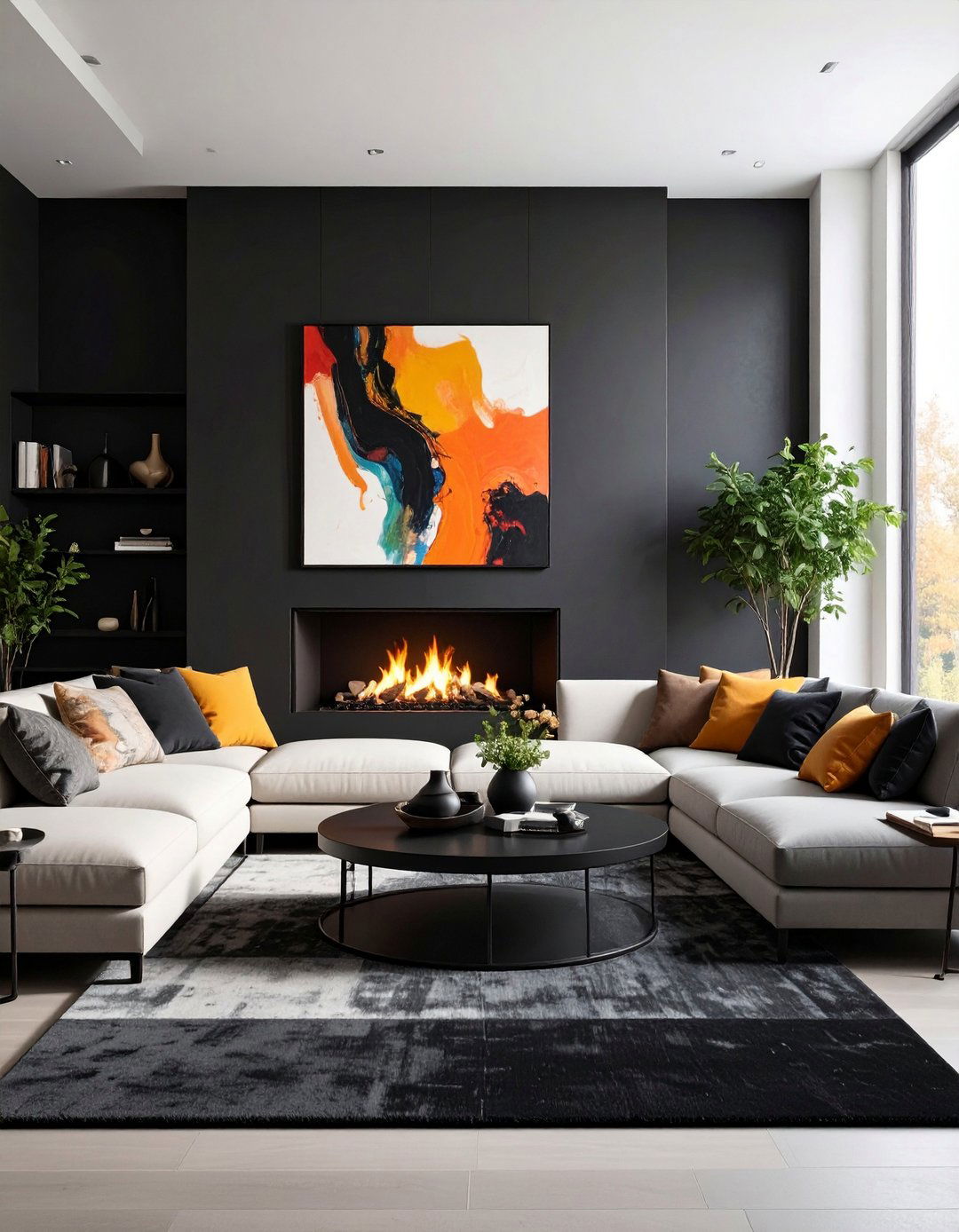
A single ebony wall sets an anchor point the moment you enter, concentrating visual weight exactly where you want it. Paint the fireplace breast, media wall, or the side that frames your sofa; the dark block instantly sharpens lines and allows colorful art or books to pop. Keep adjacent walls lighter—warm white or pale taupe—so daylight bounces farther and the contrast feels intentional rather than gloomy. If you rent, high-quality peel-and-stick panels mimic matte paint without long-term commitment. Finish with a matching area rug to pull the focal plane outward and create an effortless gallery effect that signals confident style.
2. Layered Lighting That Softens a Black Living Room
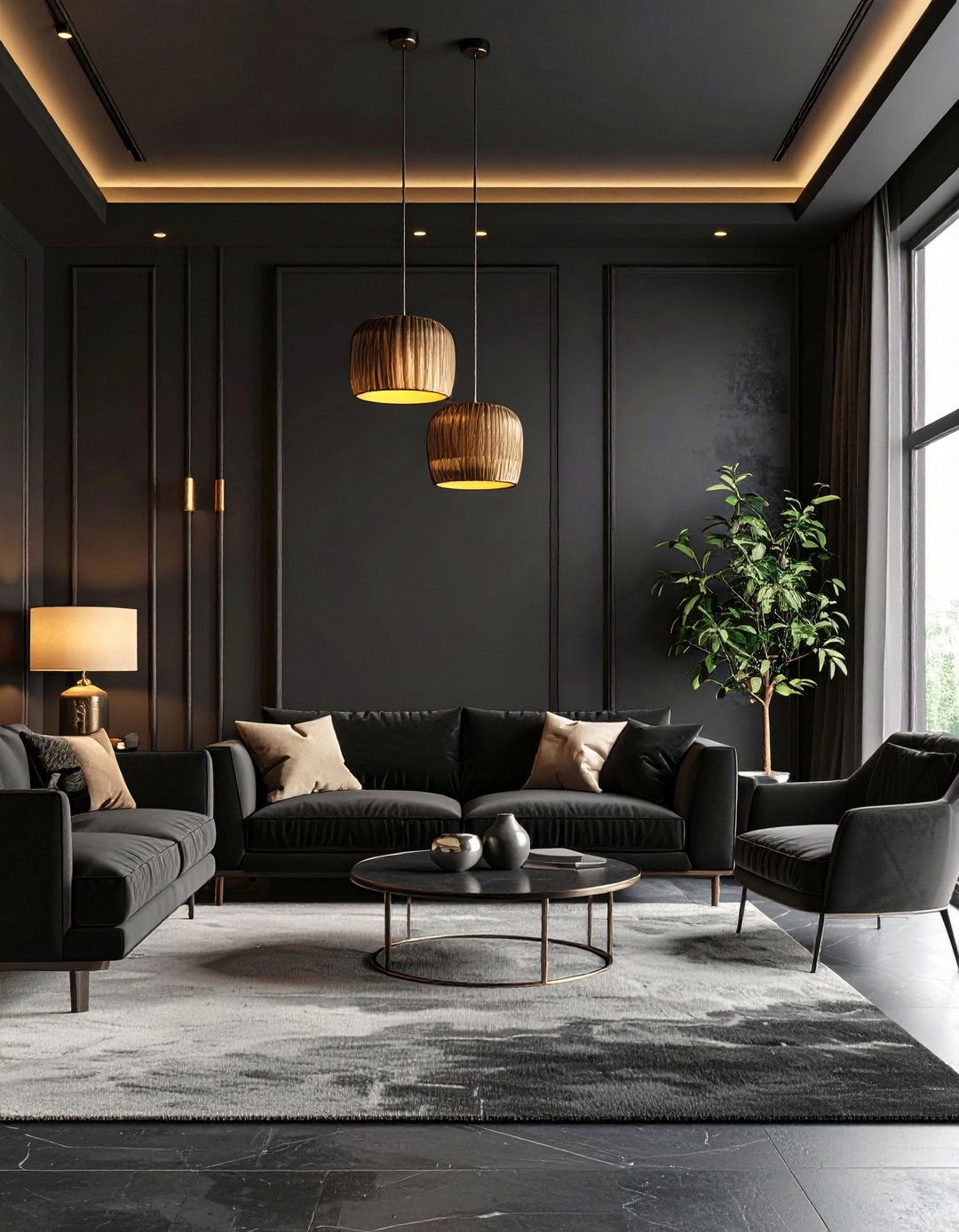
To prevent an ebony palette from swallowing depth, vary light sources by height, temperature, and direction. Begin with dimmable ceiling cans for overall glow, then drop warm pendants at seated eye-level so faces never look shadowed. Add sconces that wash the walls—up-lighting stretches vertical lines, while down-lighting highlights texture. Finally, scatter small table lamps with soft white bulbs to round off corners. This tiered strategy draws the eye across surfaces, revealing the richness of black without glare. Smart bulbs let you shift from crisp daylight for morning tasks to amber ambience for movie nights in seconds.
3. Matte Black Living Room Walls for a Cozy Cocoon

Matte finishes absorb just enough light to feel velvety, amplifying the room’s sense of calm. Paint experts recommend eggshell or flat acrylic blends that minimize reflections and hide drywall flaws. Because matte can dull in low wattage, pair it with reflective accents—glass coffee tables, brass lamp bases, or glossy ceramics—to maintain balance. The soft surface makes vibrant upholstery—think emerald velvet or terra-cotta linen—appear richer by contrast. Seal high-traffic areas with a scrub-able clear coat so fingerprints wipe off easily, and you’ll enjoy an intimate, enveloping retreat that still feels livable.
4. Glossy Paneling Elevates the Black Living Room
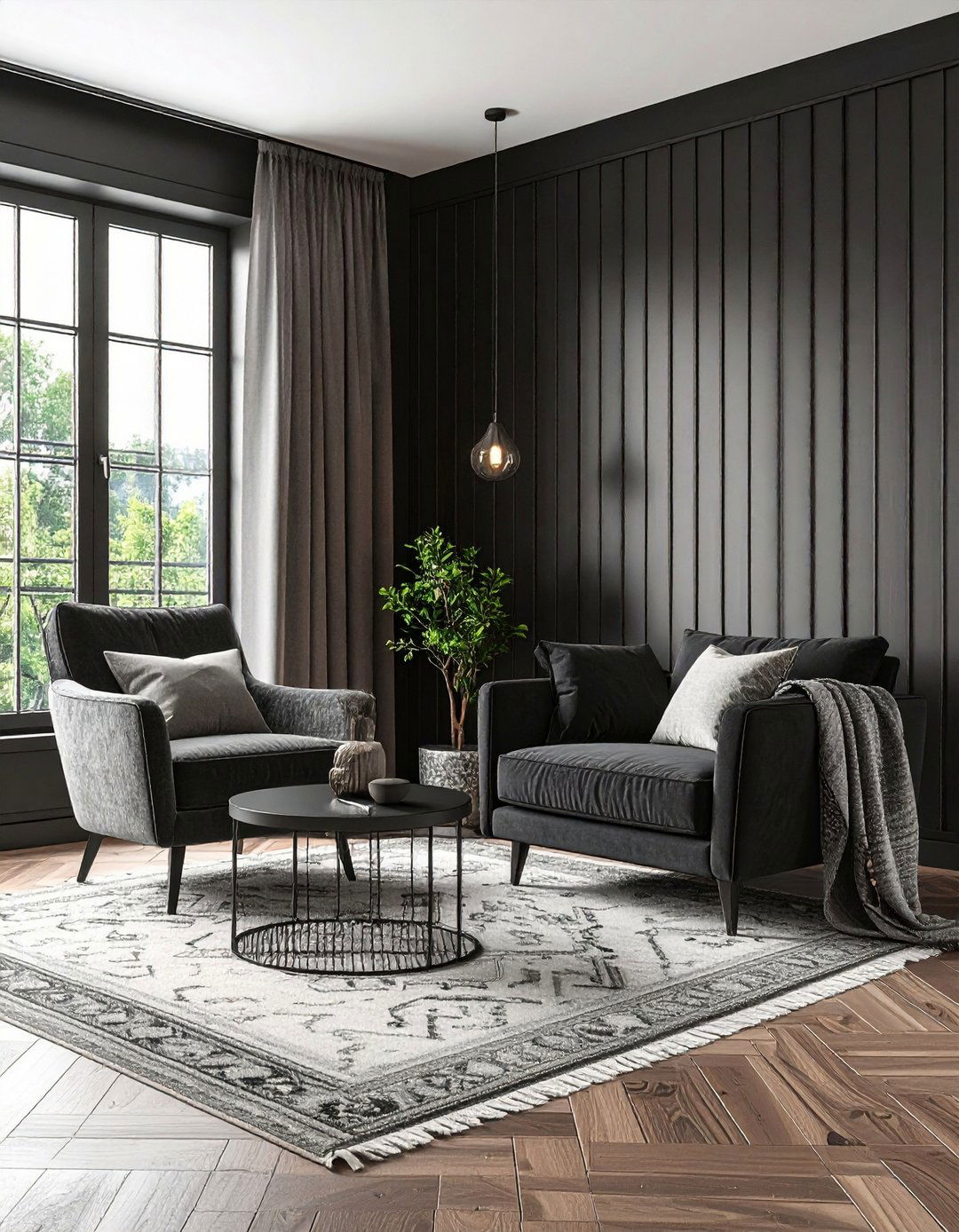
Unlike matte, lacquer-look paneling rebounds light like a polished piano, adding instant glamour. High-gloss shiplap or MDF sheets sprayed in automotive-grade enamel create mirror-like depth that expands tight quarters. Run panels vertically to heighten ceilings, or install narrow horizontal battens for a boutique-hotel vibe. Because shiny walls spotlight imperfections, invest in professional prep—sand, prime, and caulk relentlessly. Temper the sheen with textured fabrics: nubby wool throws, boucle accent chairs, or a plush Moroccan rug stop the space from feeling sterile, fusing old-Hollywood drama with everyday comfort.
5. Graphic Black-and-White Patterns Energize the Living Room

Bold monochrome prints wake up an all-dark envelope, delivering movement without extra color. Consider oversized houndstooth pillows, a geometric area rug, or a checkerboard ottoman to break up expanses of charcoal upholstery. When patterns repeat at least three times across the room—on textiles, artwork, and small accessories—they read cohesive rather than chaotic. If you fear overload, keep scale varied: one large rug, medium-sized cushions, and a few delicate vases. Crisp white stripes or grids also bounce existing light, ensuring your noir scheme stays lively and social instead of solemn.
6. Textured Black Living Room Wallpaper Adds Depth

Embossed grass cloth, linen-look vinyl, or raised geometric papers introduce dimension that flat paint can’t match. Texture catches sidelight, casting soft shadows that give black surprising warmth. Opt for peel-and-stick options rated for repositioning if you crave flexibility. To avoid pattern fatigue, paper only the sofa wall or the alcoves flanking built-ins, then paint the remaining surfaces in a matching hue. The subtle tactile contrast draws guests closer, inviting touch and conversation—proof that darkness can feel irresistibly welcoming.
7. Pops of Jewel Tones in a Black Living Room
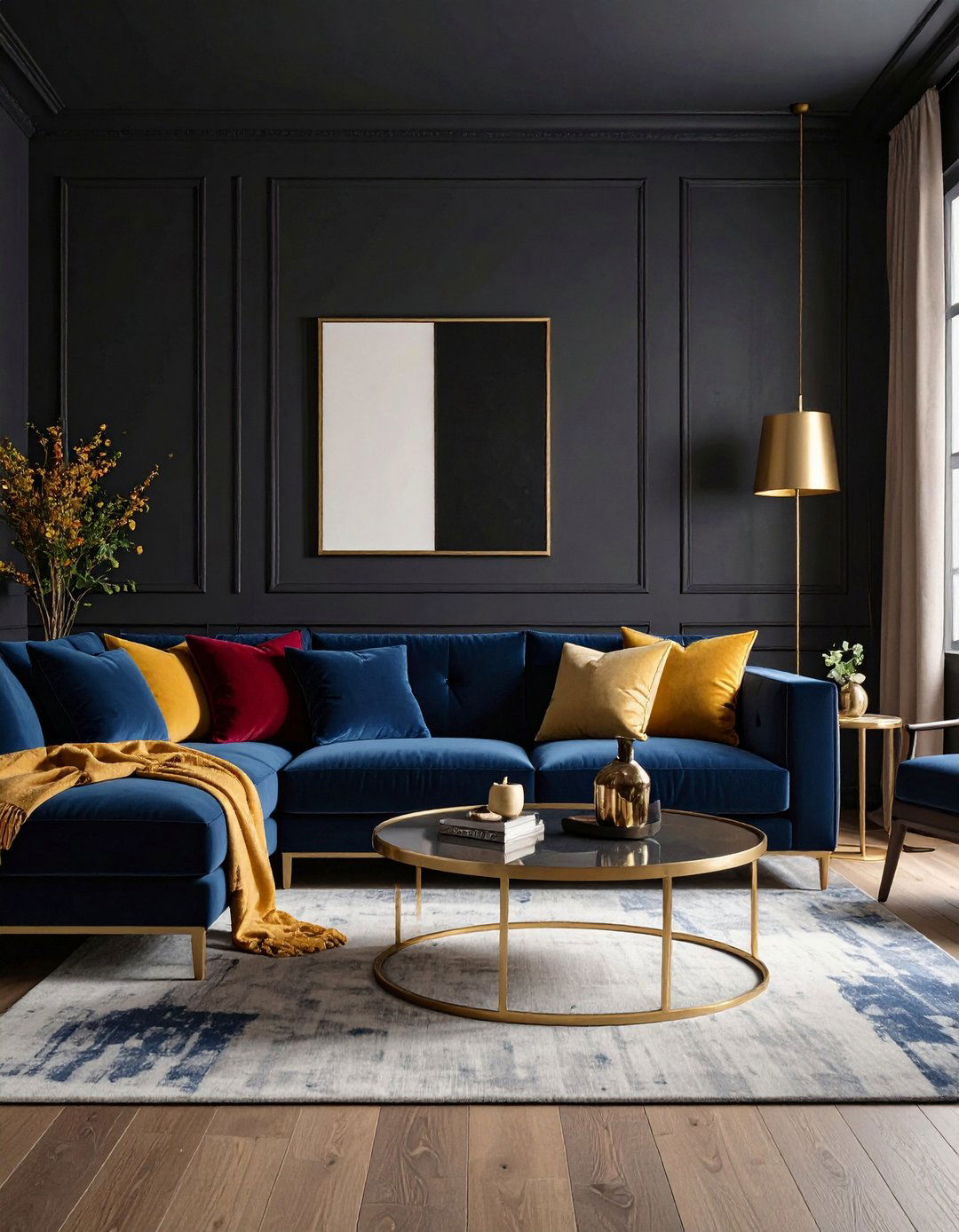
Saturated colors—sapphire, ruby, citrine—glow like stained glass against an obsidian backdrop. Interior pros recommend choosing one hero hue and repeating it through scatter cushions, art, and a statement chair so the palette feels curated, not random. Metallic trims in gold or brass echo gemstone undertones and carry the eye around the room. Keep big furniture neutral to allow rotating seasonal accents; that way a quick pillow swap shifts the mood from winter garnet to summer aquamarine without repainting a wall.
8. Metallic Highlights Brighten the Black Living Room
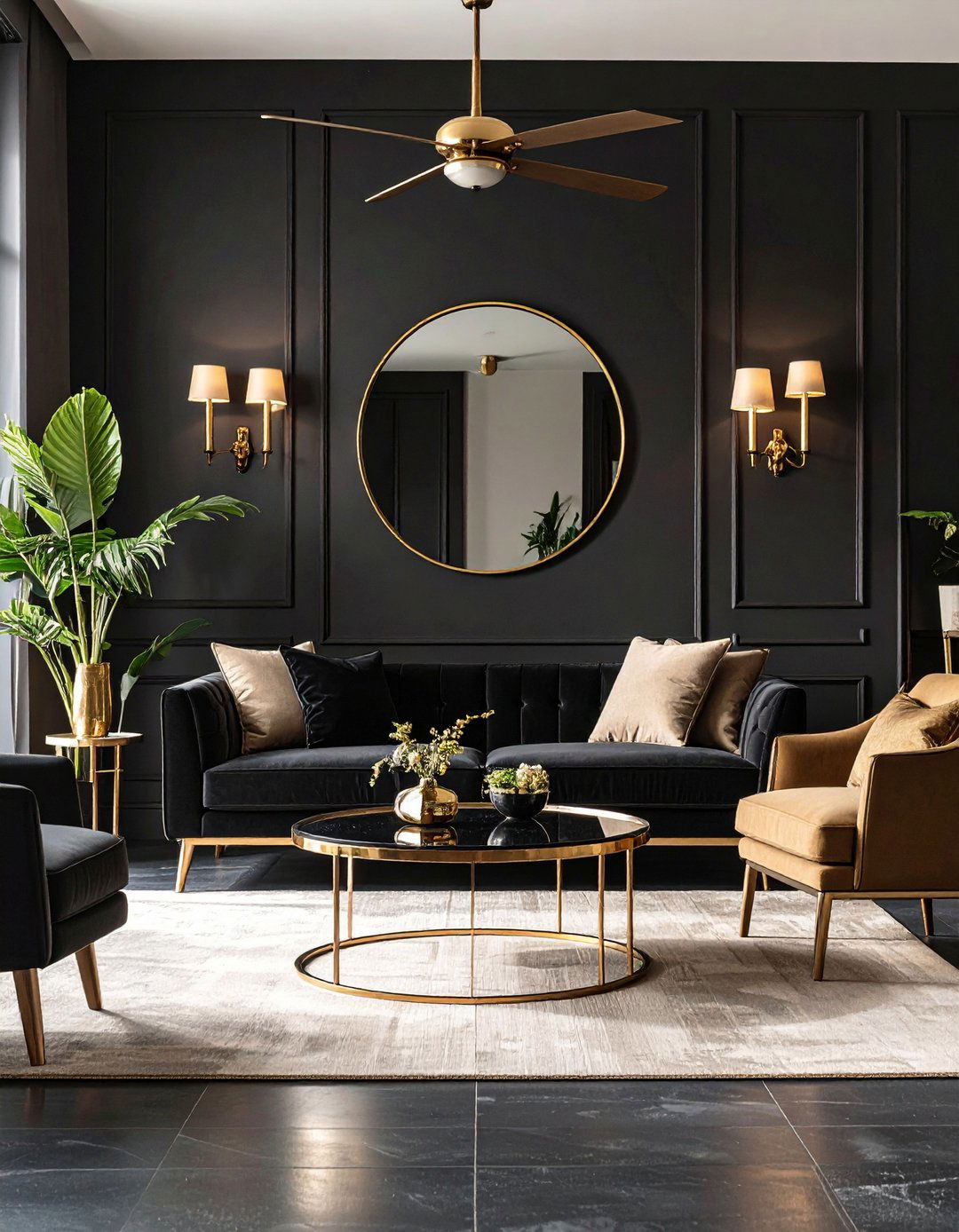
Metallics act like jewelry, reflecting micro-glints that lift heavy pigments. Brass sconces, chrome coffee-table legs, or a brushed-nickel ceiling fan introduce sparkle that travels as people move. Balance warm and cool tones: pair brass with cognac leather, chrome with grey textiles. For cohesion, repeat the same metal finish at least three times—lighting, hardware, and décor—so the shimmer reads intentional. If you’re wary of clutter, a single oversized gilt mirror opposite a window doubles natural light while visually enlarging the room.
9. Greenery Revives an Inky Black Living Room
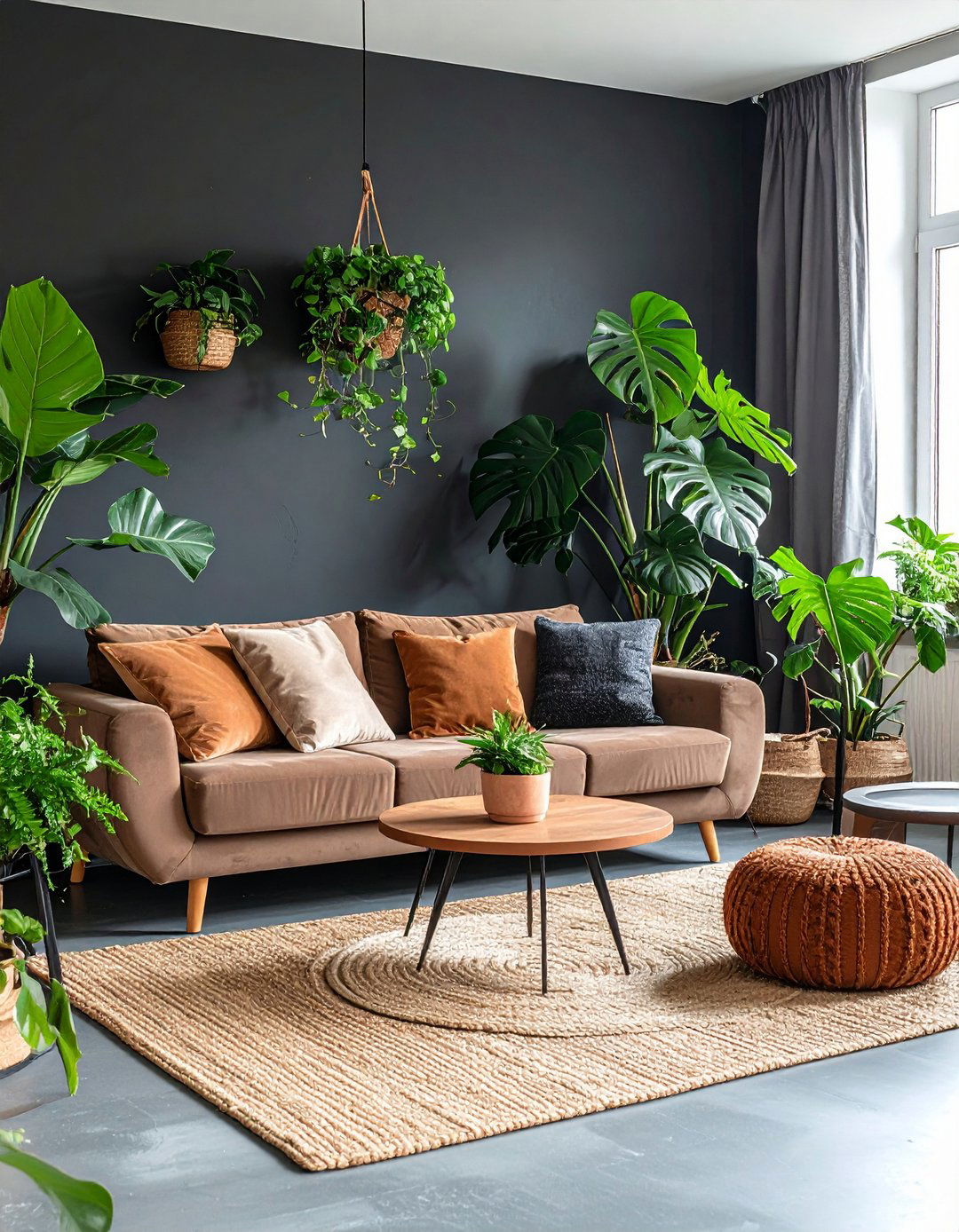
Lush plants pop vividly against a dark canvas, turning every leaf into living art. Fiddle-leaf figs, monstera, or trailing pothos thrive indoors and contrast beautifully with matte walls. Choose terracotta or natural-fiber planters to inject warmth and break up monochrome surfaces. Cluster three heights—floor, stool, and shelf—to create a mini urban jungle that purifies air and softens hard edges. Even faux stems work if maintenance is a challenge; high-quality replicas still deliver that essential hit of organic vitality.
10. Minimalist Black Living Room Creates Zen Calm
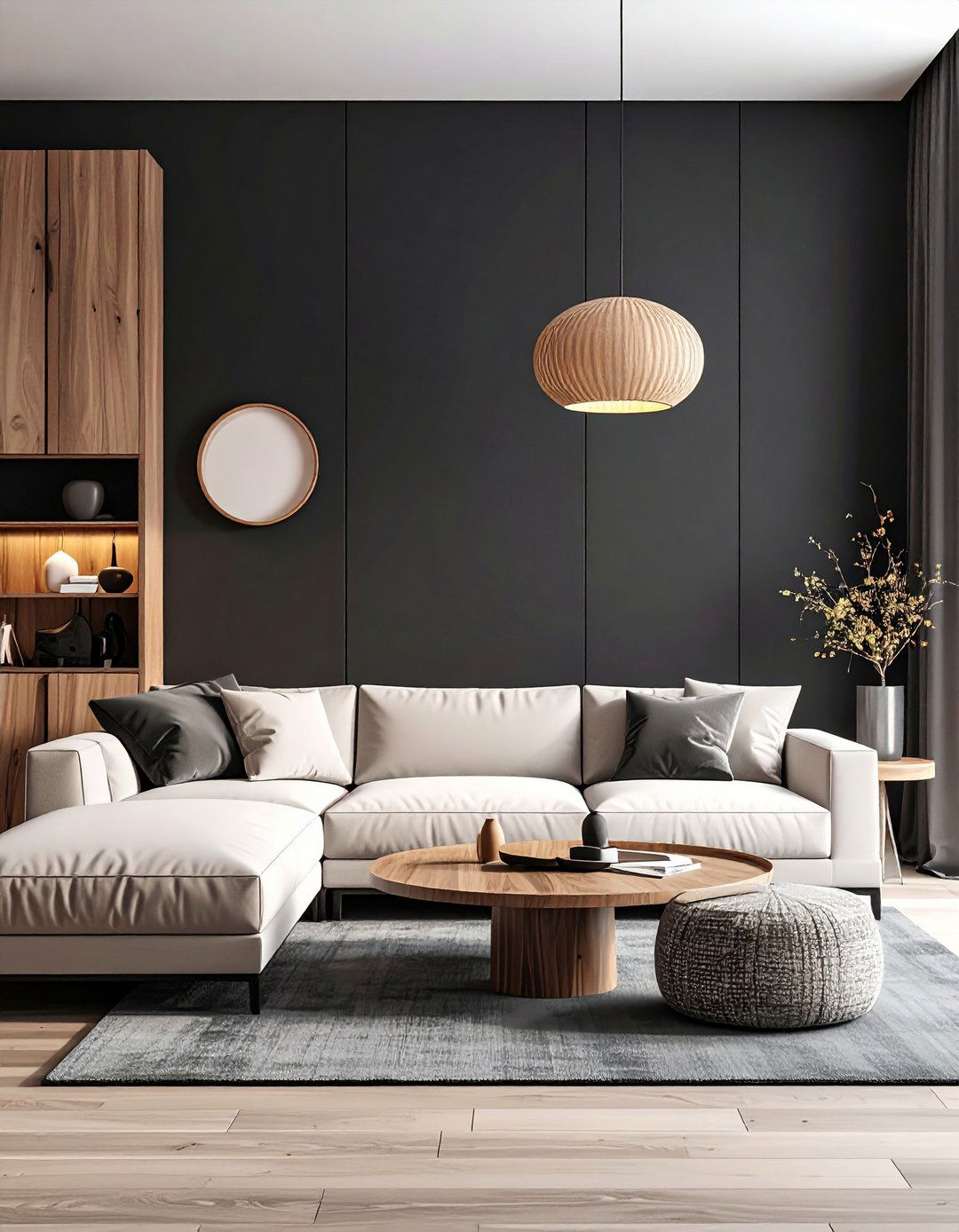
Stripping décor to essentials lets form and shadow take center stage. Limit the palette to black, off-white, and wood, prioritizing clean-lined furniture with low visual noise. Hide electronics in wall-mounted cabinets painted to match the backdrop so screens vanish when off. A single sculptural lamp or ceramic vessel becomes a meditative focal point. This restrained approach shines in small apartments, where black visually recedes to make edges blur and the room feel surprisingly spacious.
11. Vintage Touches Warm a Modern Black Living Room
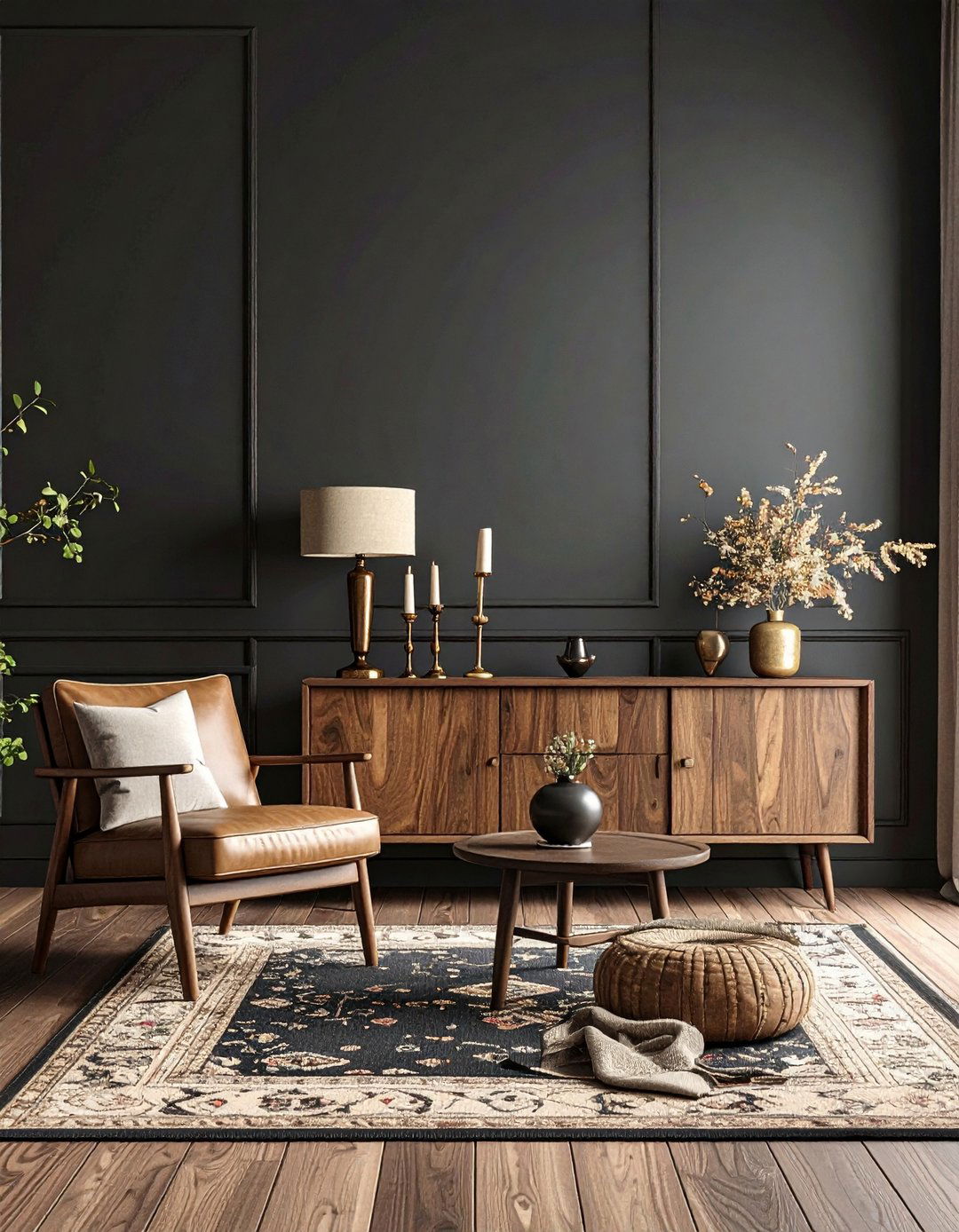
Antique sideboards, patinated brass candlesticks, and heirloom rugs temper black’s sharpness with history. Design strategists suggest balancing one vintage piece per modern element—think mid-century teak media console beside a sleek sectional—for a layered narrative. Rich woods introduce red or honey undertones that play against cool charcoal, creating a luxe, lived-in ambience. To spotlight character details—wood grain, aged leather—install picture-light LEDs above your favorite find; the warm beam turns timeworn textures into art.
12. Natural Wood Balances a Black Living Room Palette
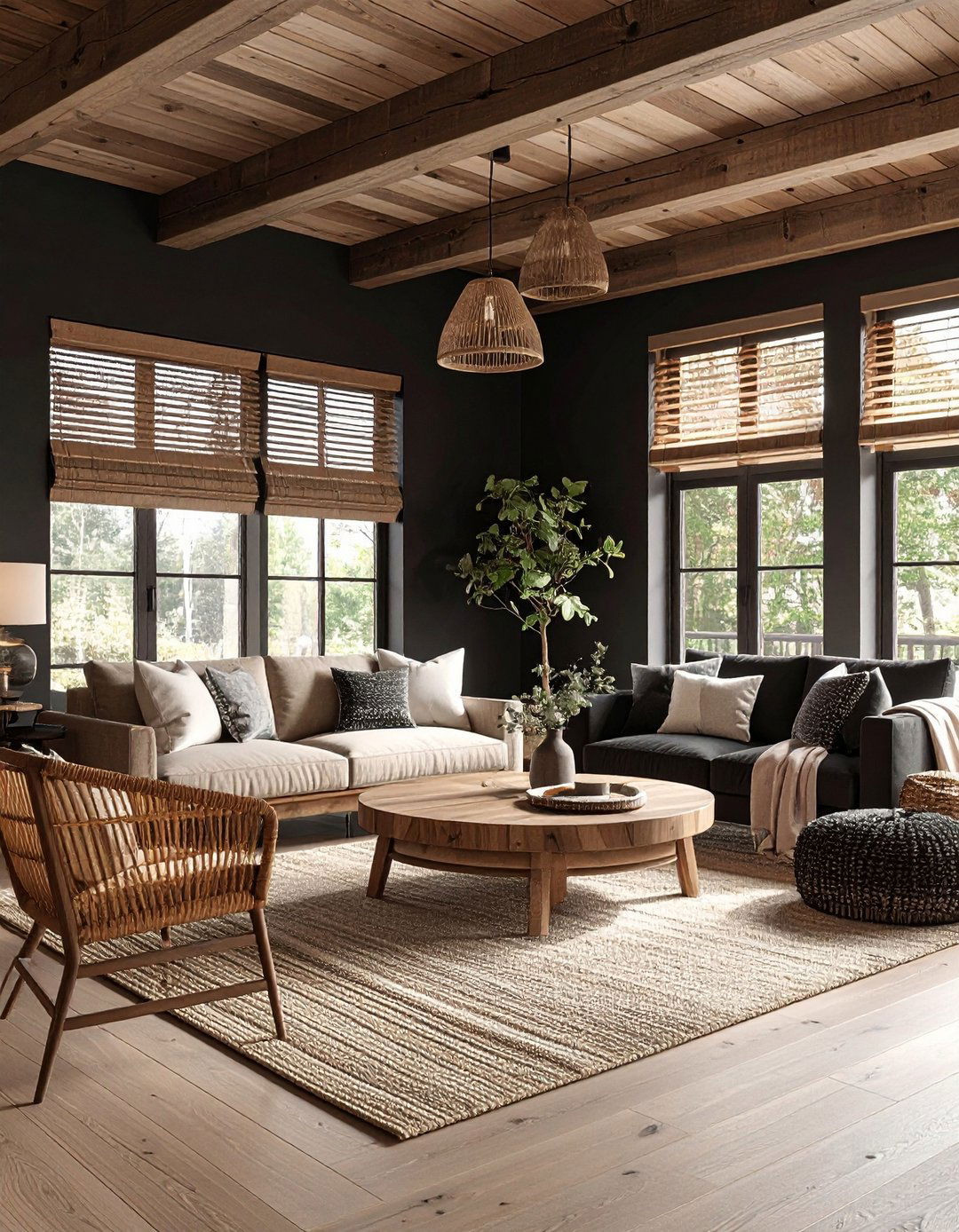
Unfinished oak beams, walnut coffee tables, or rattan accent chairs inject earthy warmth that prevents a dark scheme from veering industrial. Experts recommend medium-to-light species so the contrast remains soft rather than severe. Repeat timber tones at floor level—think wood-slat blinds or a herringbone floor—to anchor the room. Seal surfaces with matte oil to echo wall finishes, unifying gloss levels and maintaining the tranquil vibe.
13. Gallery-Style Art Walls in a Black Living Room
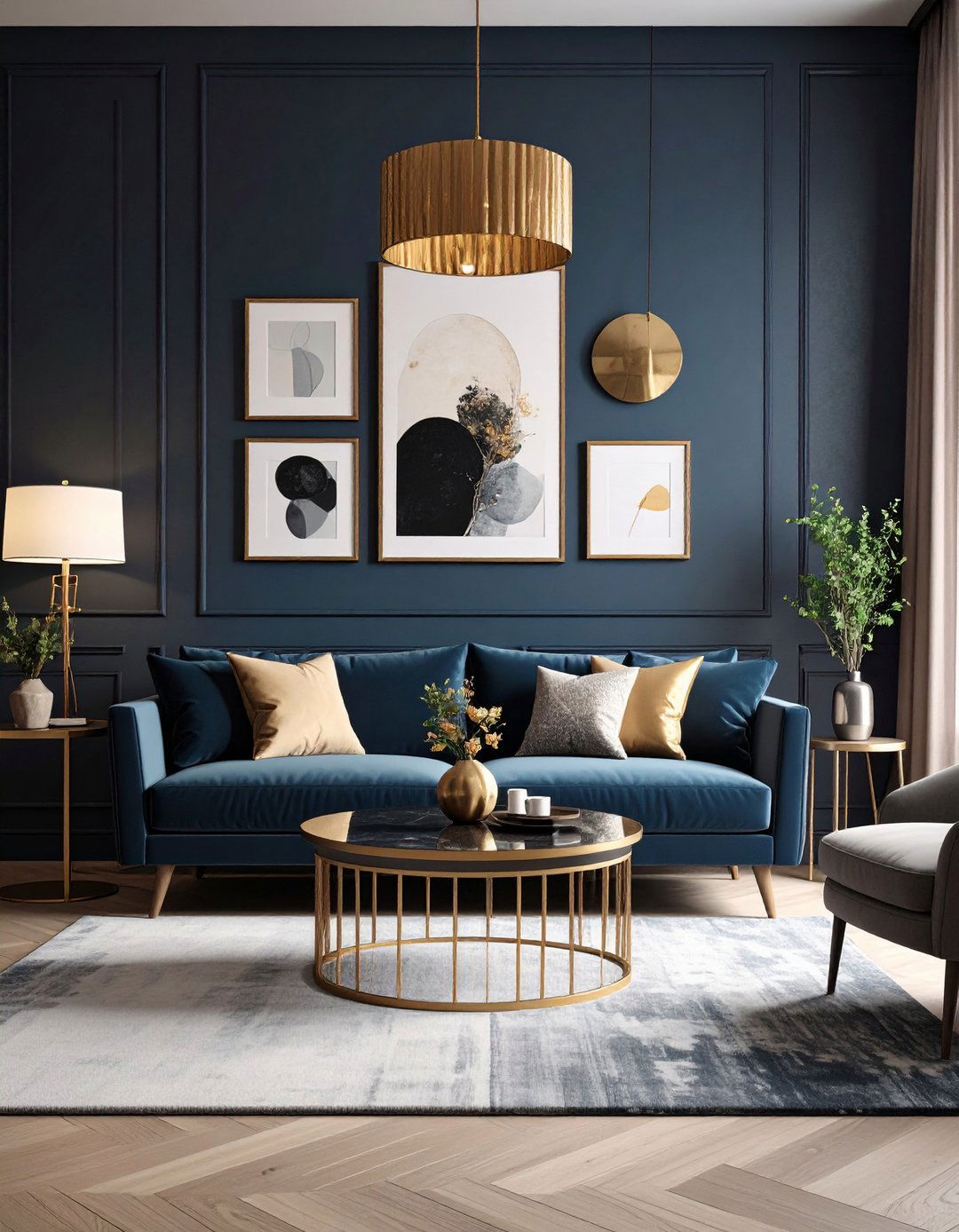
Black walls behave like museum velvet, letting artwork glow. Hang pieces with generous negative space between frames so each has breathing room, and install slim picture lights to mimic exhibition lighting. White-bordered mats intensify contrast, making even affordable prints feel upscale. If you prefer oversized canvases, lean one casually atop a console for a modern, flexible display—no measuring or drilling required.
14. Black Living Room Ceilings for Total Immersion

Painting the fifth wall black blurs boundaries, enveloping occupants in chic intimacy. This trick works best in rooms with ample daylight or lighter flooring to prevent cave-like vibes. Semi-gloss finishes reflect pendant light, creating a subtle sheen overhead. Pair with narrow vertical wall sconces that draw the gaze upward, showcasing architectural cornices or beams you’d otherwise miss.
15. Layering Soft Charcoal Textiles in a Black Living Room

Depth emerges when you stack fabrics from charcoal to ink: a wool rug, linen curtains, and a velvet throw each absorb light differently, crafting tactile richness. Stick to three textile weights—light, medium, heavy—to prevent overload. Introduce a single contrasting cushion in camel or rust for relief. This sensory approach invites lounging and makes a predominantly dark space feel undeniably cozy.
16. Framed Views with Black Living Room Window Casings
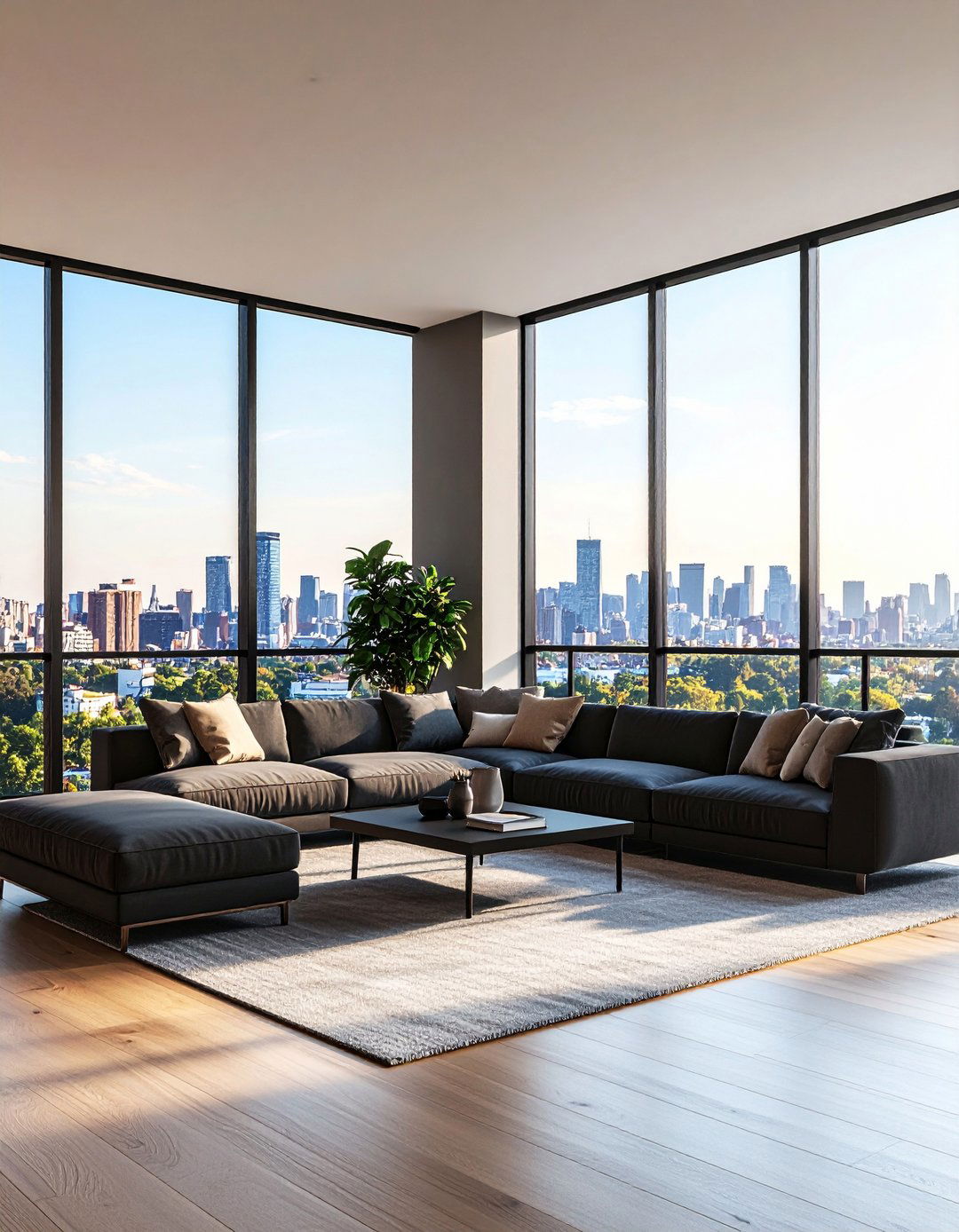
Slim black frames around windows behave like picture borders, sharpening outdoor greenery and cityscapes alike. Opt for powder-coated aluminum if you’re renovating, or fake the look with removable vinyl wrap on existing trim. Inside, leave sills bare or style with minimal objects so daylight remains the hero. The strong outline visually extends black décor outdoors, making even modest patios feel connected to the living zone.
17. Zoning an Open-Plan Black Living Room
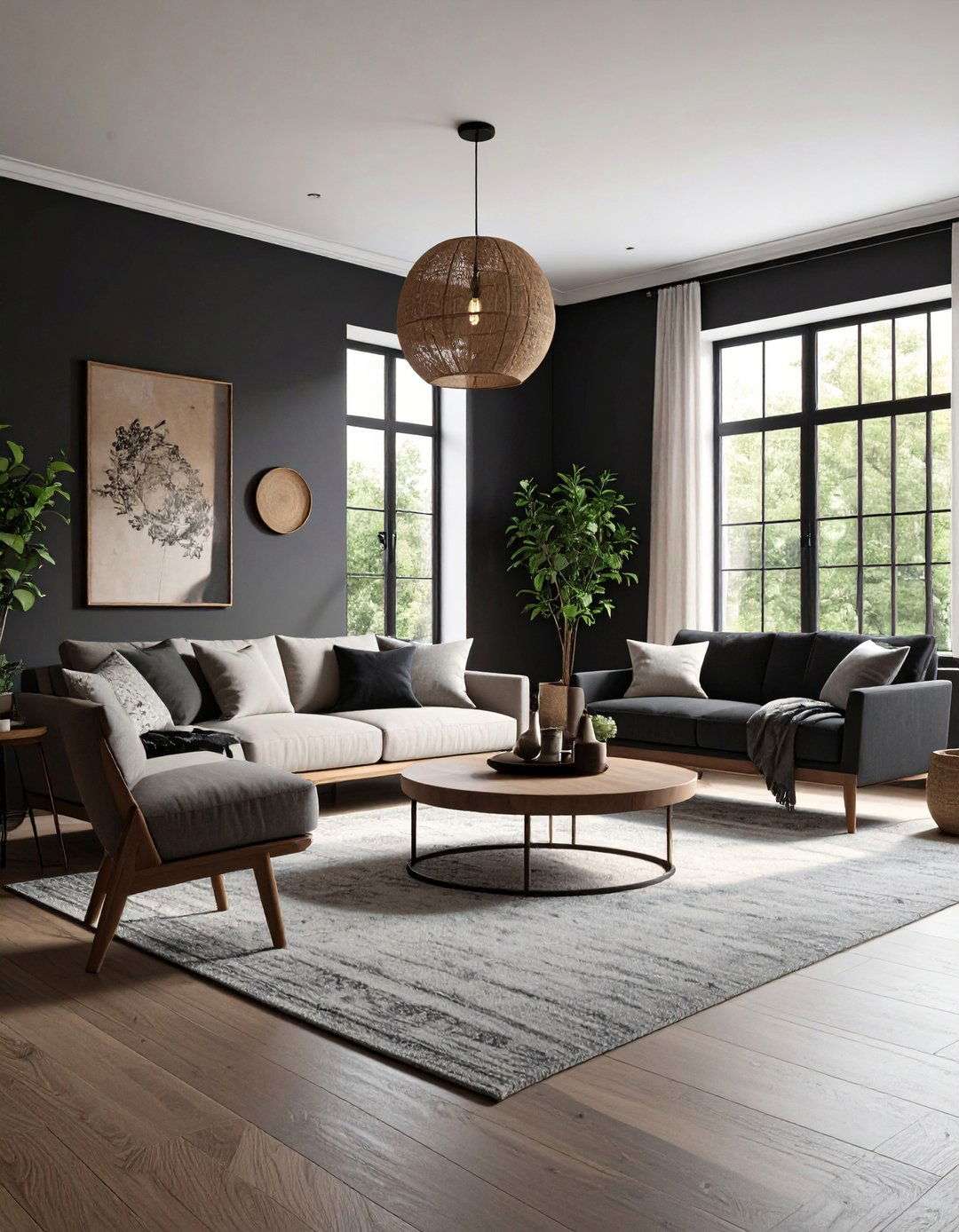
In combined kitchen-living layouts, strategic dark paint delineates lounging from dining without walls. Coat the seating nook in black while keeping adjacent cooking areas lighter; the sharp boundary fools the eye into perceiving separate rooms. Echo the division with a contrasting rug and back-of-sofa console that doubles as storage. Under-cabinet LEDs or pendant clusters emphasize the transition line, guiding circulation naturally.
18. Monochrome Black Living Room Furniture Mix
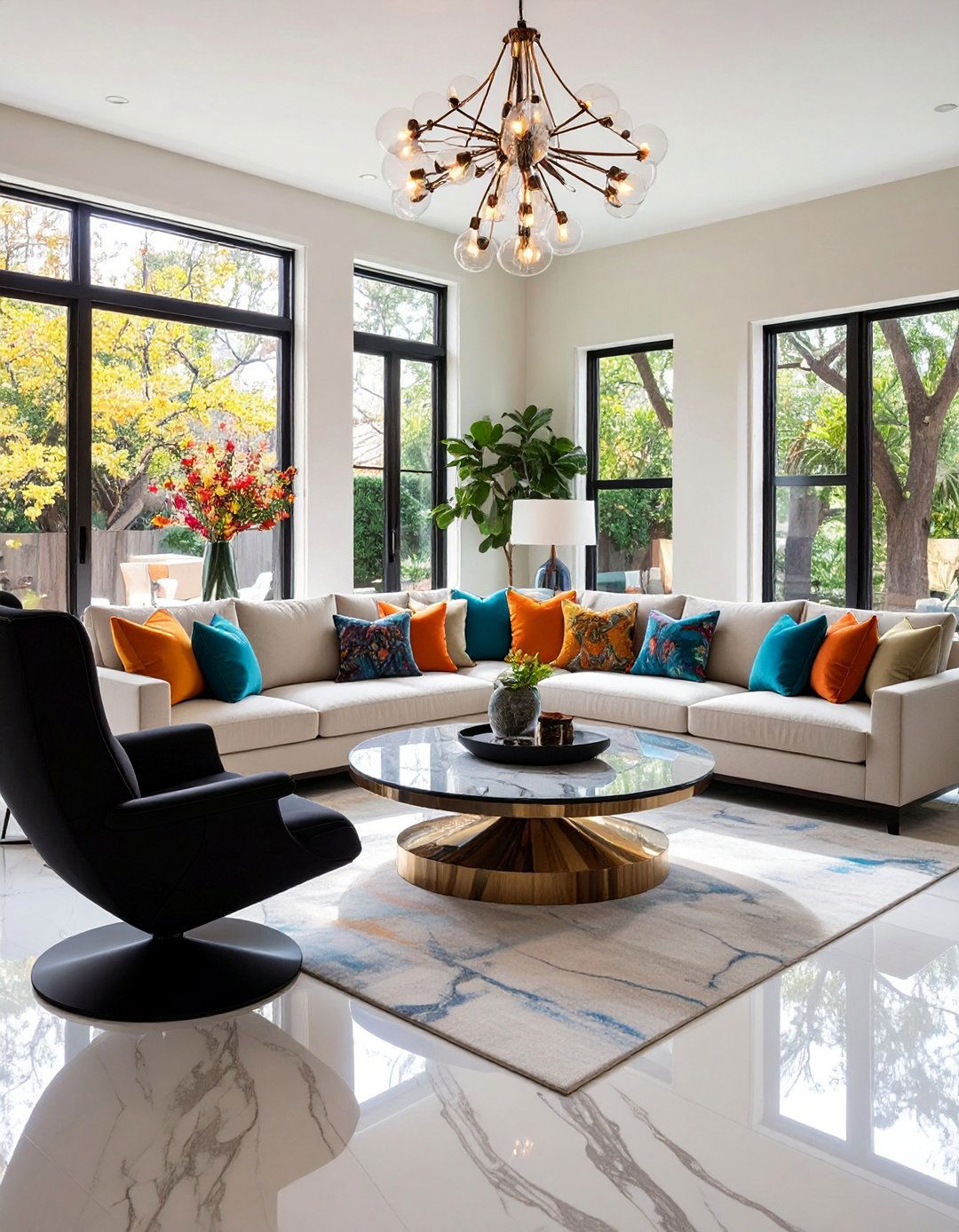
Merging varied silhouettes—wingback chair, low-profile sectional, sculptural side tables—adds dynamism while staying color-coordinated. Designers advise mixing materials (leather, boucle, lacquer) so pieces don’t visually merge into a blob. Anchor the arrangement with a lighter rug or marble coffee table to break up the mass. Transparent acrylic occasional tables lighten the perimeter without introducing a new hue.
19. Smart Lighting Accents in a Black Living Room

Voice-controlled LEDs hidden behind crown molding or under shelves bathe walls in customizable hues—amber for movie night, cool white for reading—accentuating black surfaces without new fixtures. Schedule daylight-mimicking scenes to boost mood during winter; the colored wash reflects subtly on matte paint, creating an ever-changing backdrop that keeps monotone décor engaging.
20. Seasonal Styling Updates for a Black Living Room
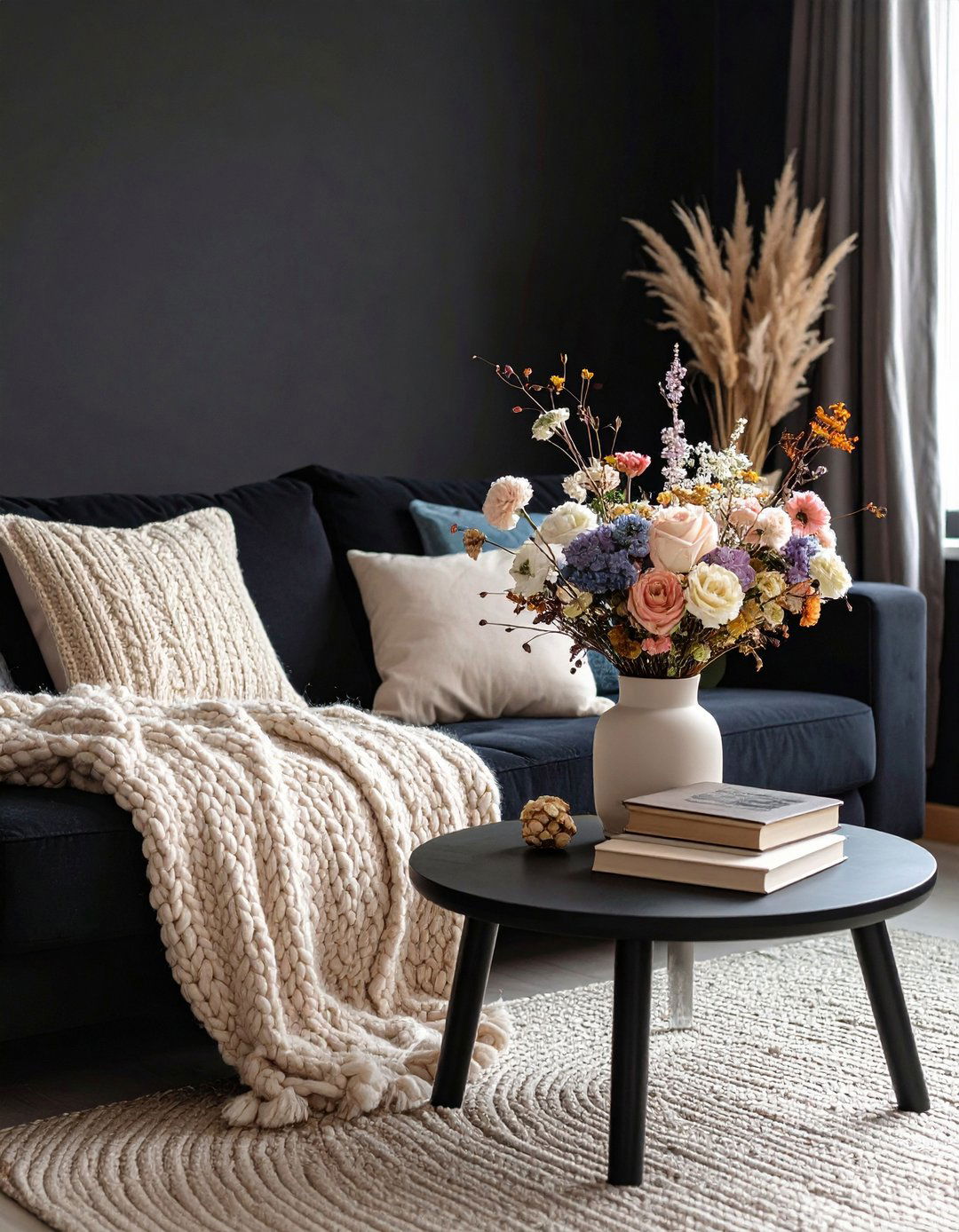
Because black forms a neutral stage, swapping lightweight throws for chunky knits or pastel florals for dried grasses instantly shifts the room’s temperament. Stylists recommend storing décor in labeled bins by season and cycling items every three months for freshness. Even something as simple as rotating coffee-table books keeps the setting dynamic without major expenditure. This habit ensures your noir sanctuary never feels stagnant, encouraging ongoing creativity.
Conclusion:
Black living rooms thrive on contrast, texture, and thoughtful illumination—principles that empower any homeowner to wield darkness as a tool for comfort and flair. From a single accent wall to fully immersive matte envelopments, the ideas above demonstrate how adaptable and welcoming ebony can be when balanced with light, color, and personality. Embrace one strategy or layer several; either way, you’ll craft a space where shadow becomes the backdrop for brilliant living.


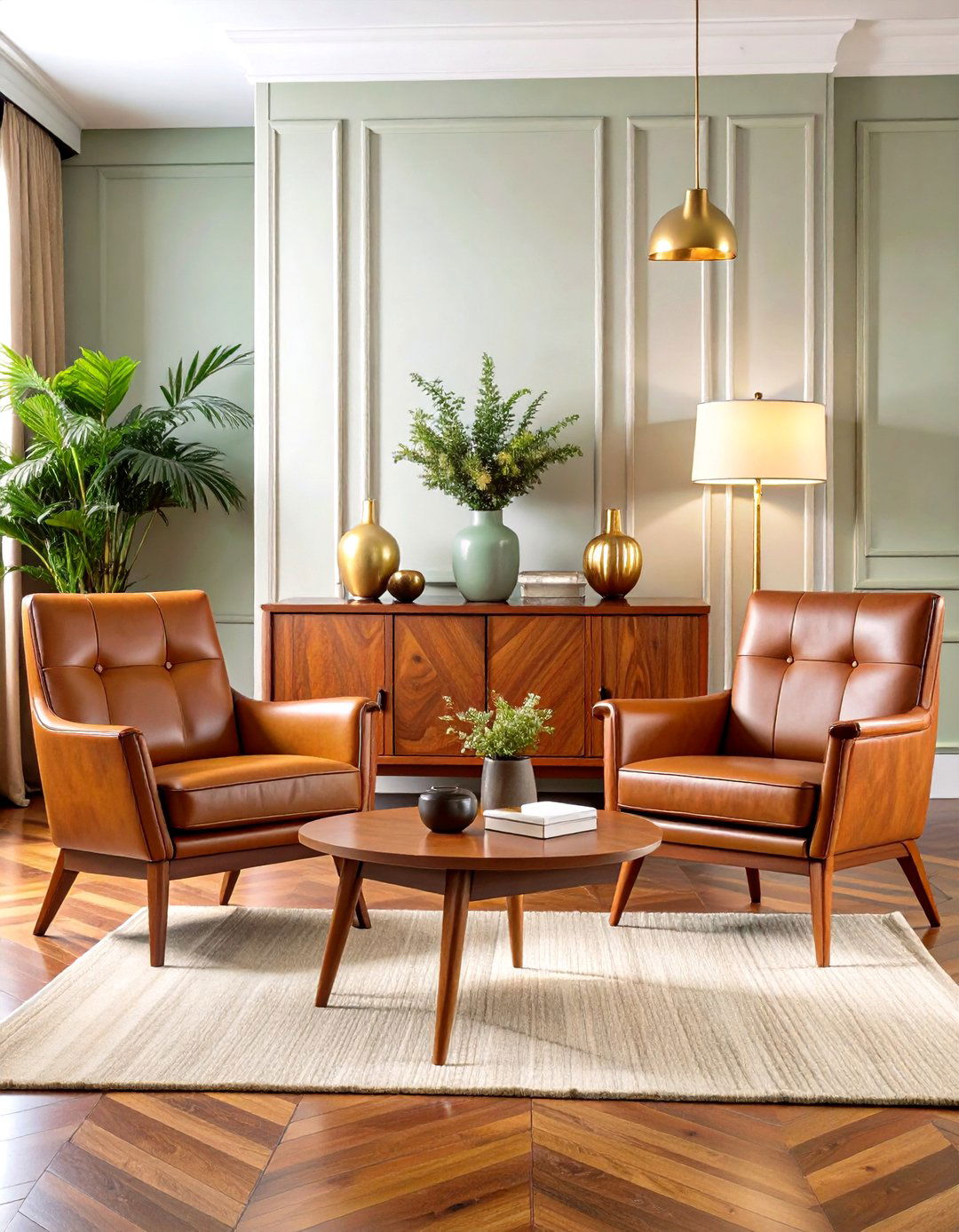
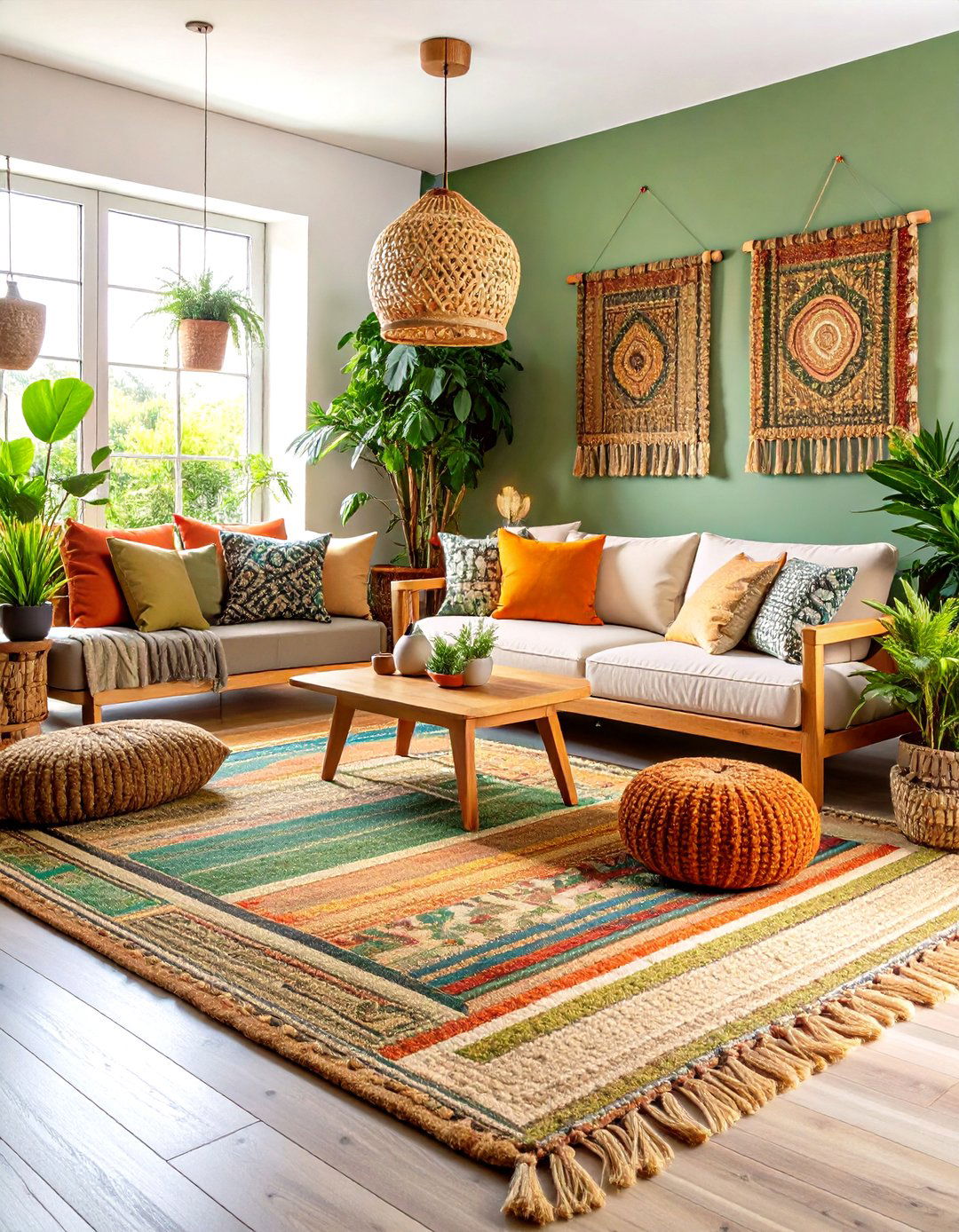
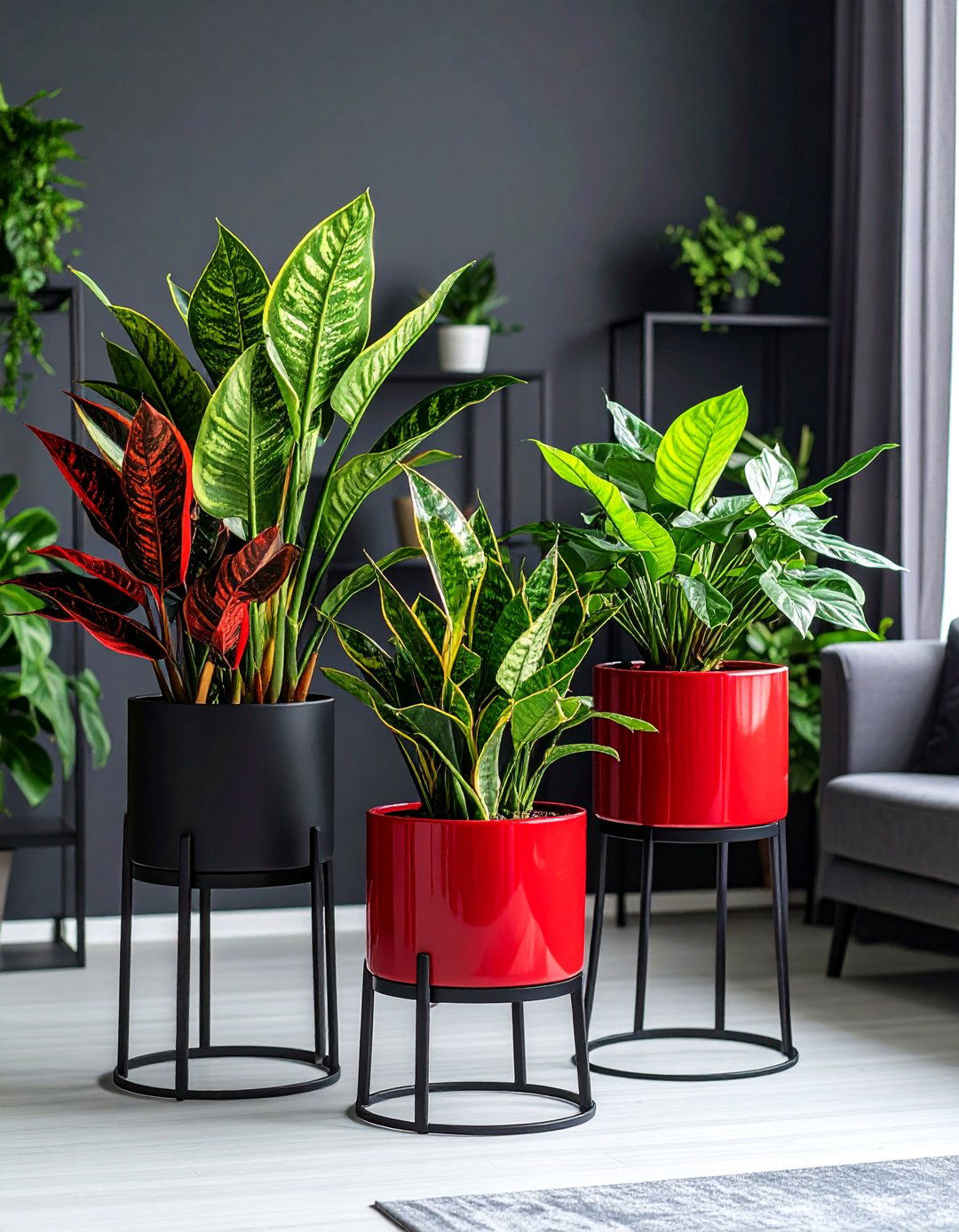
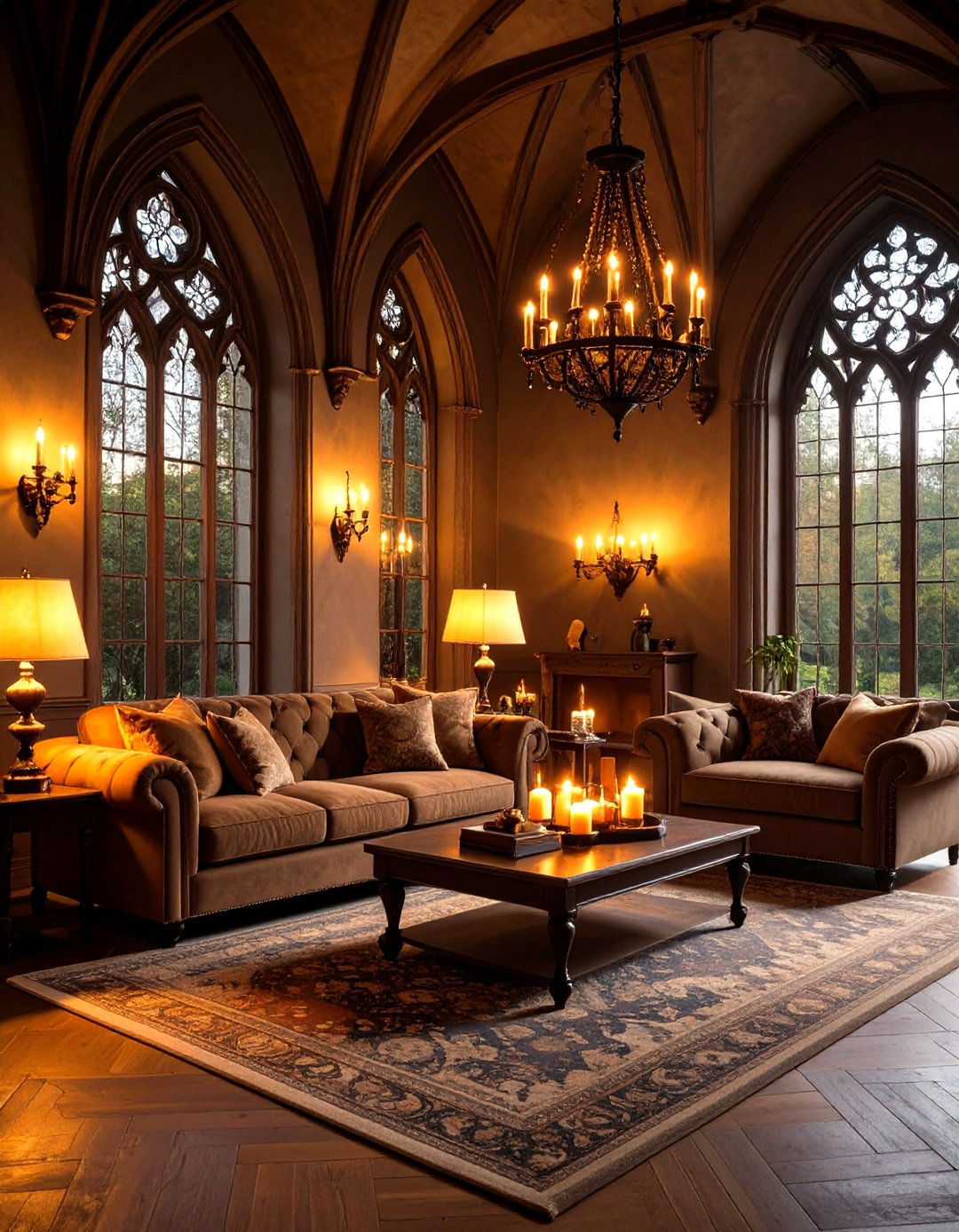

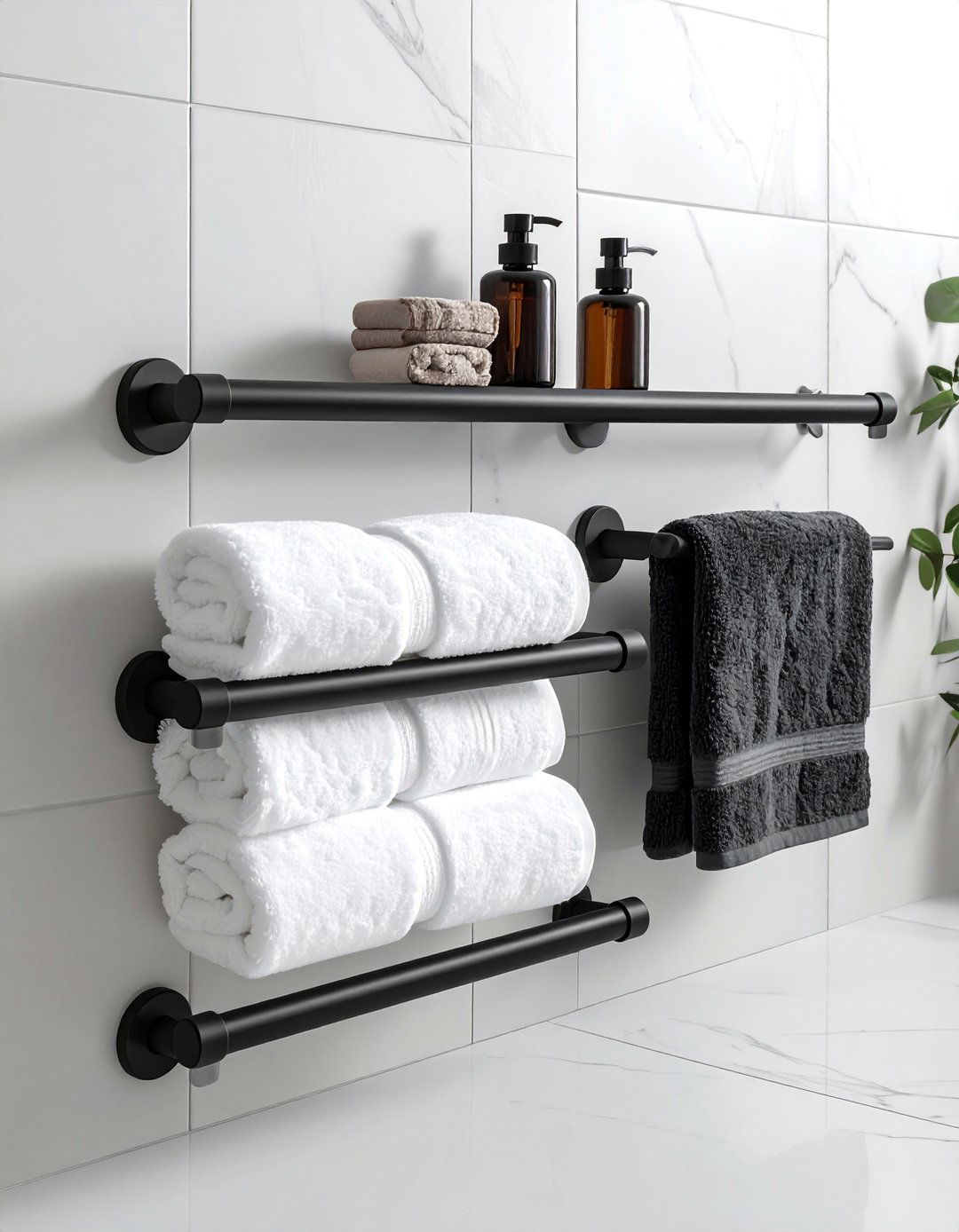
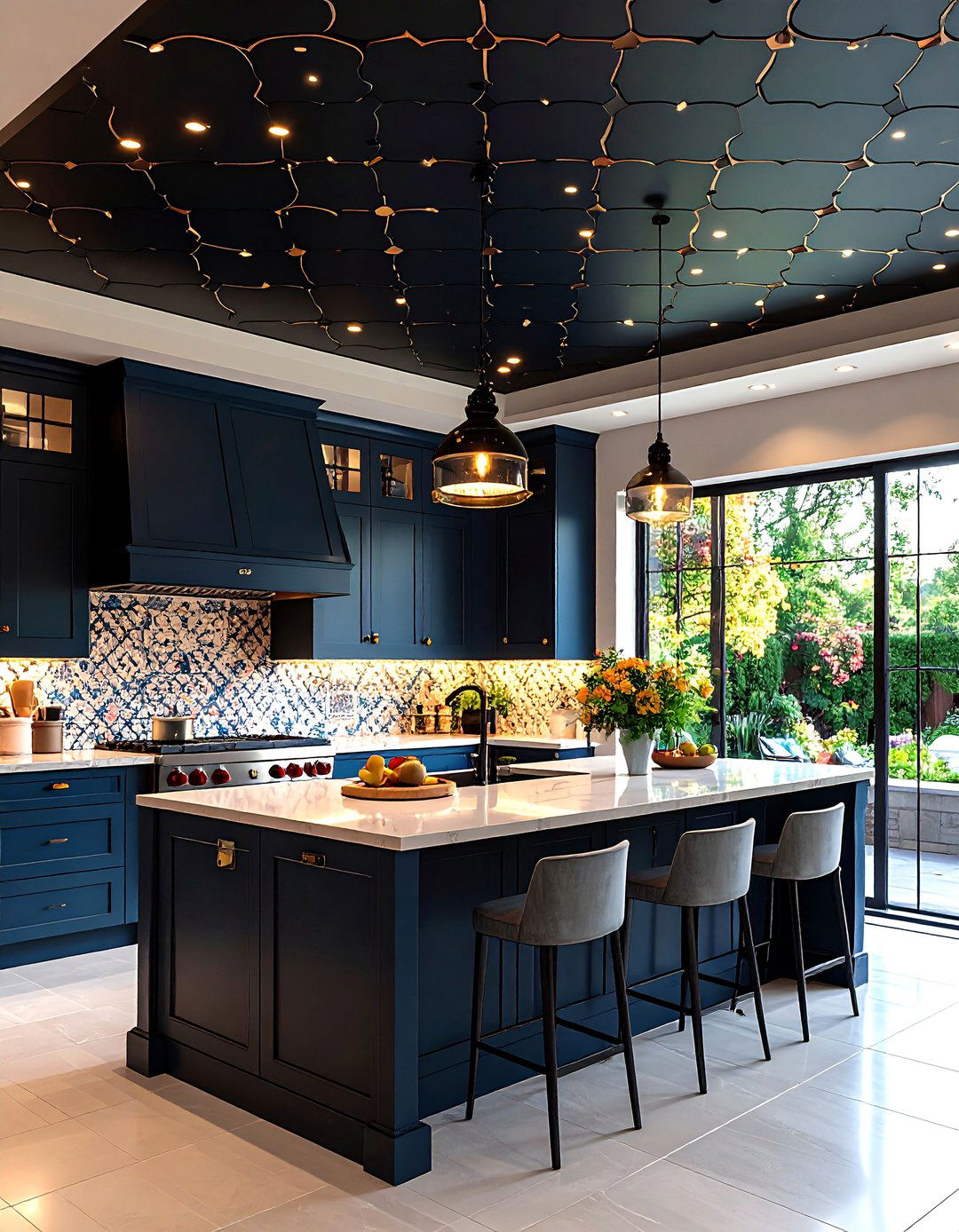
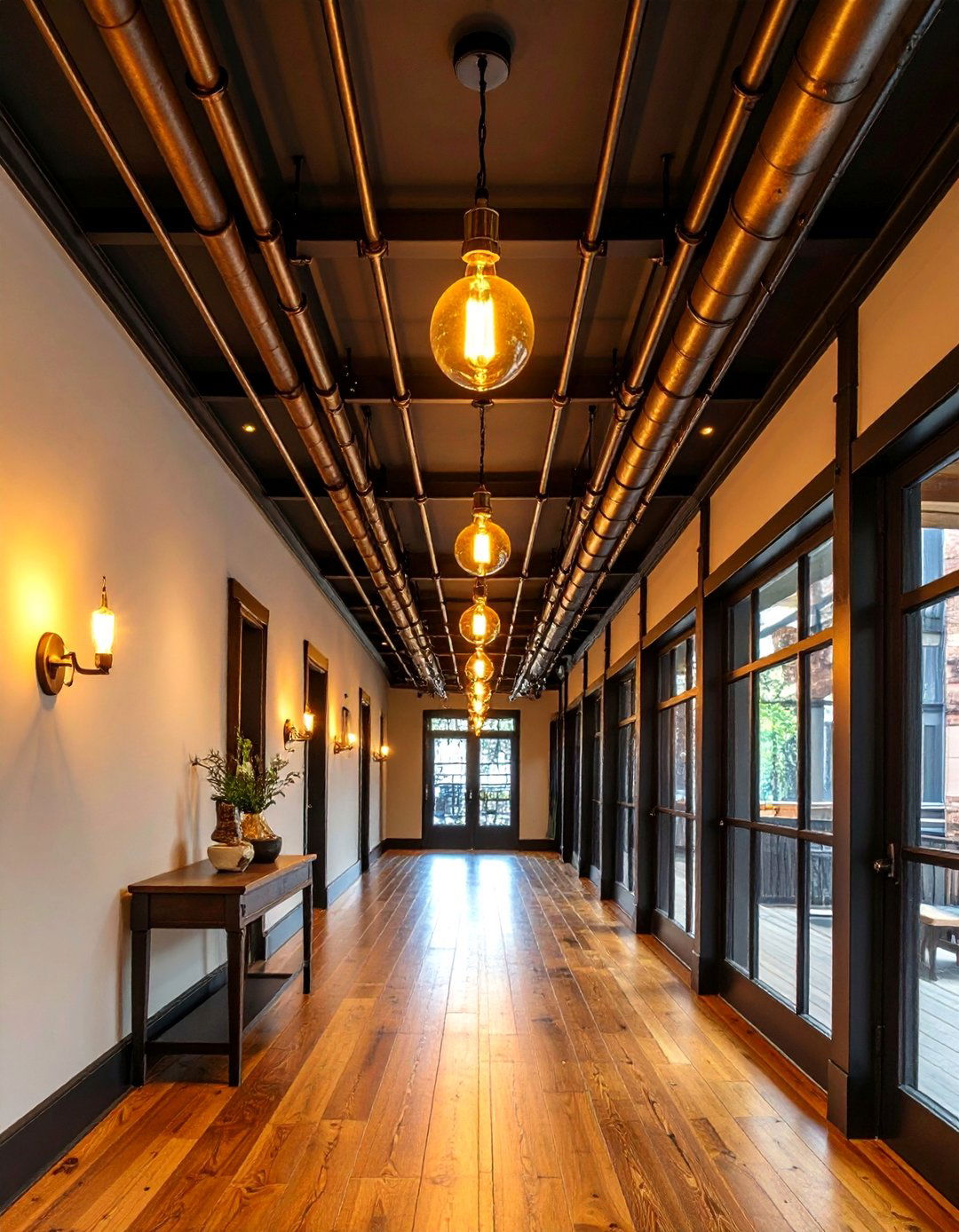
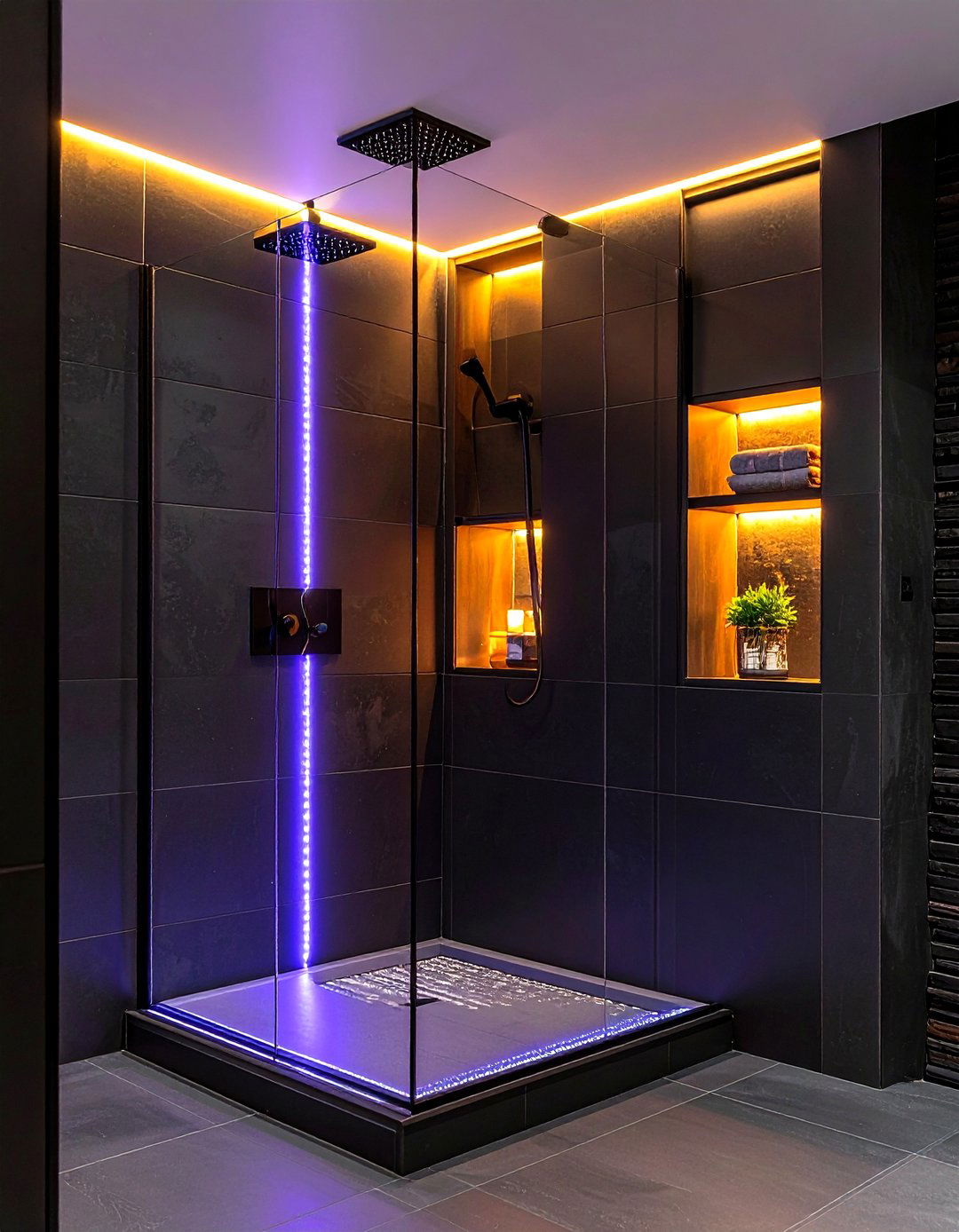

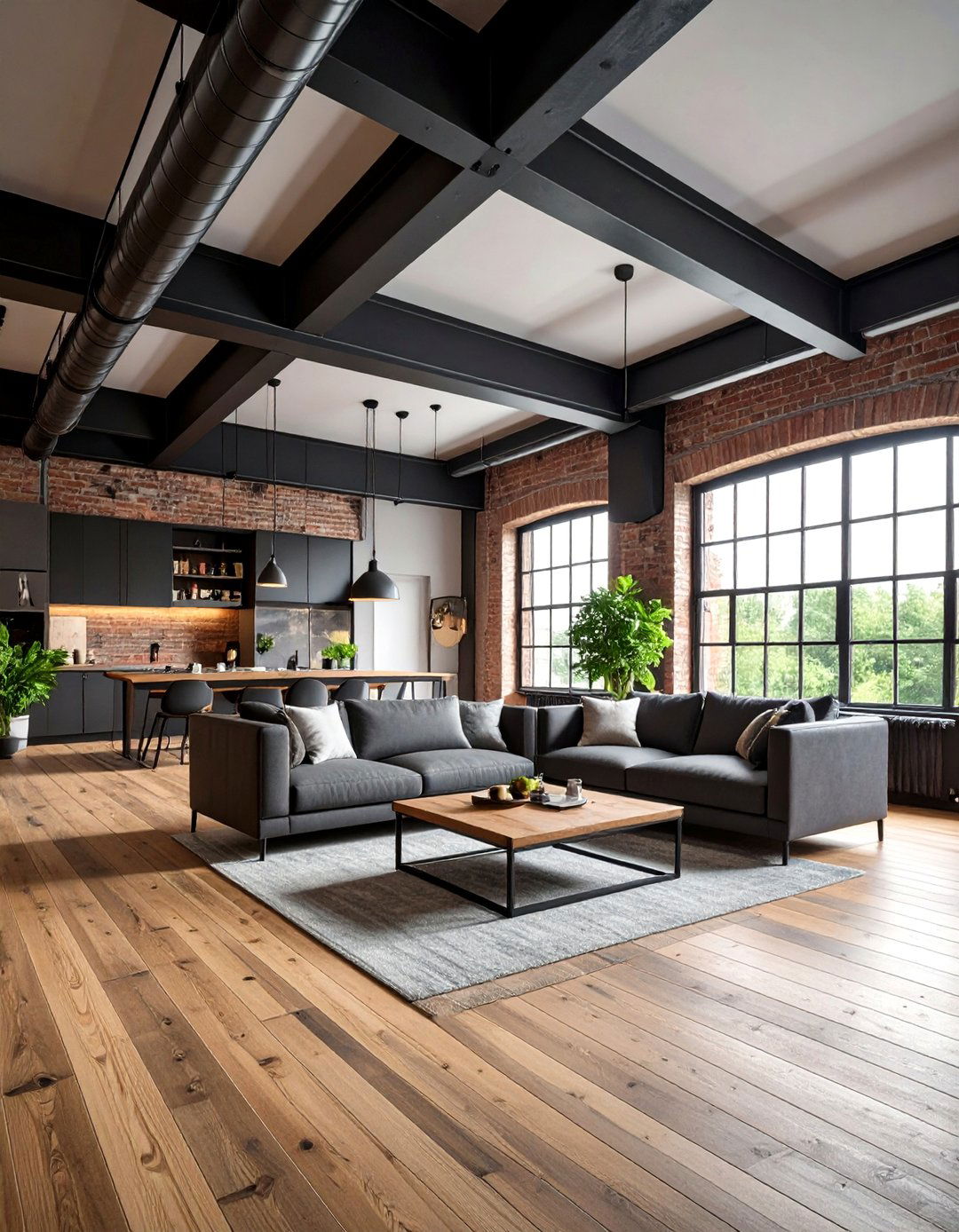
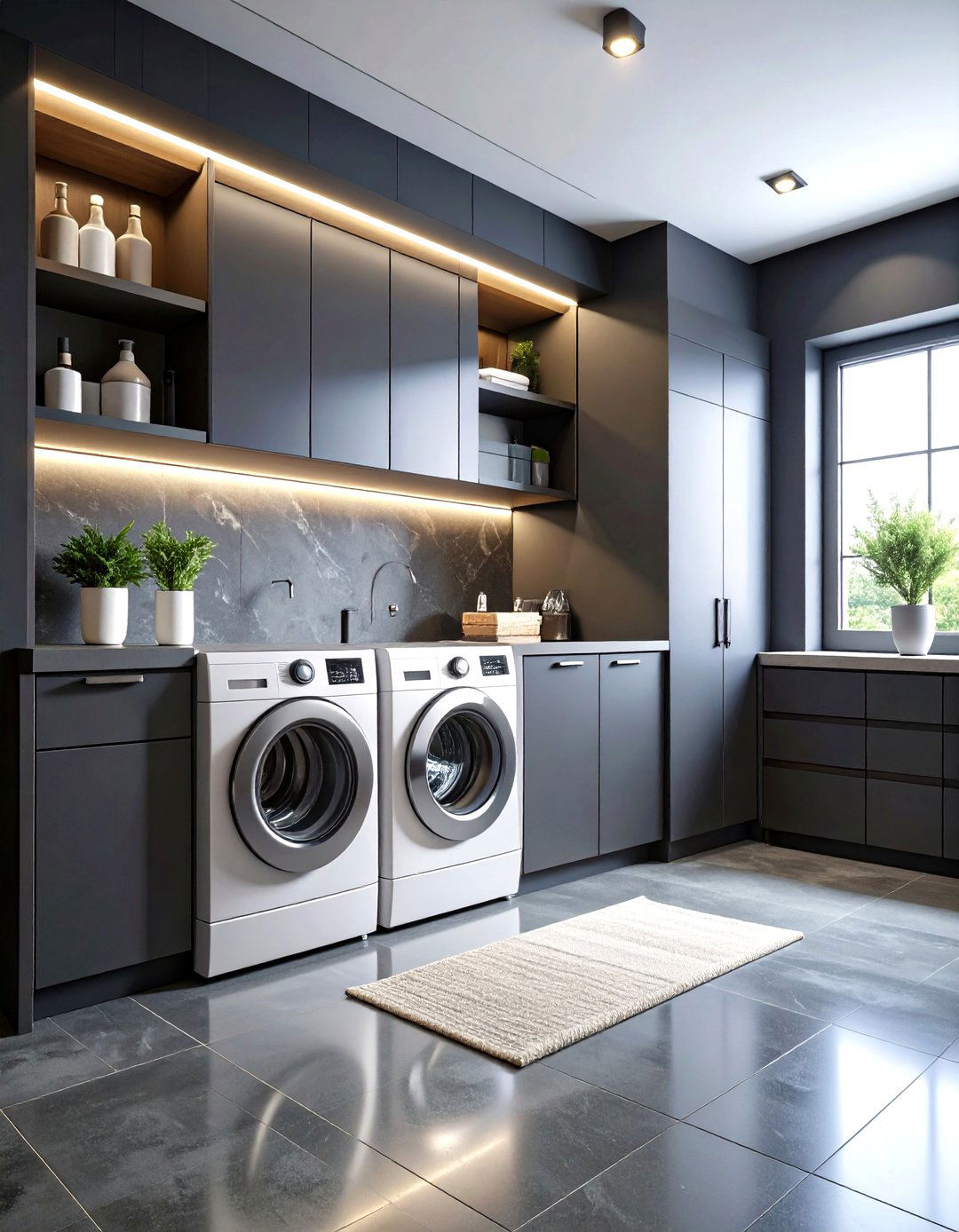

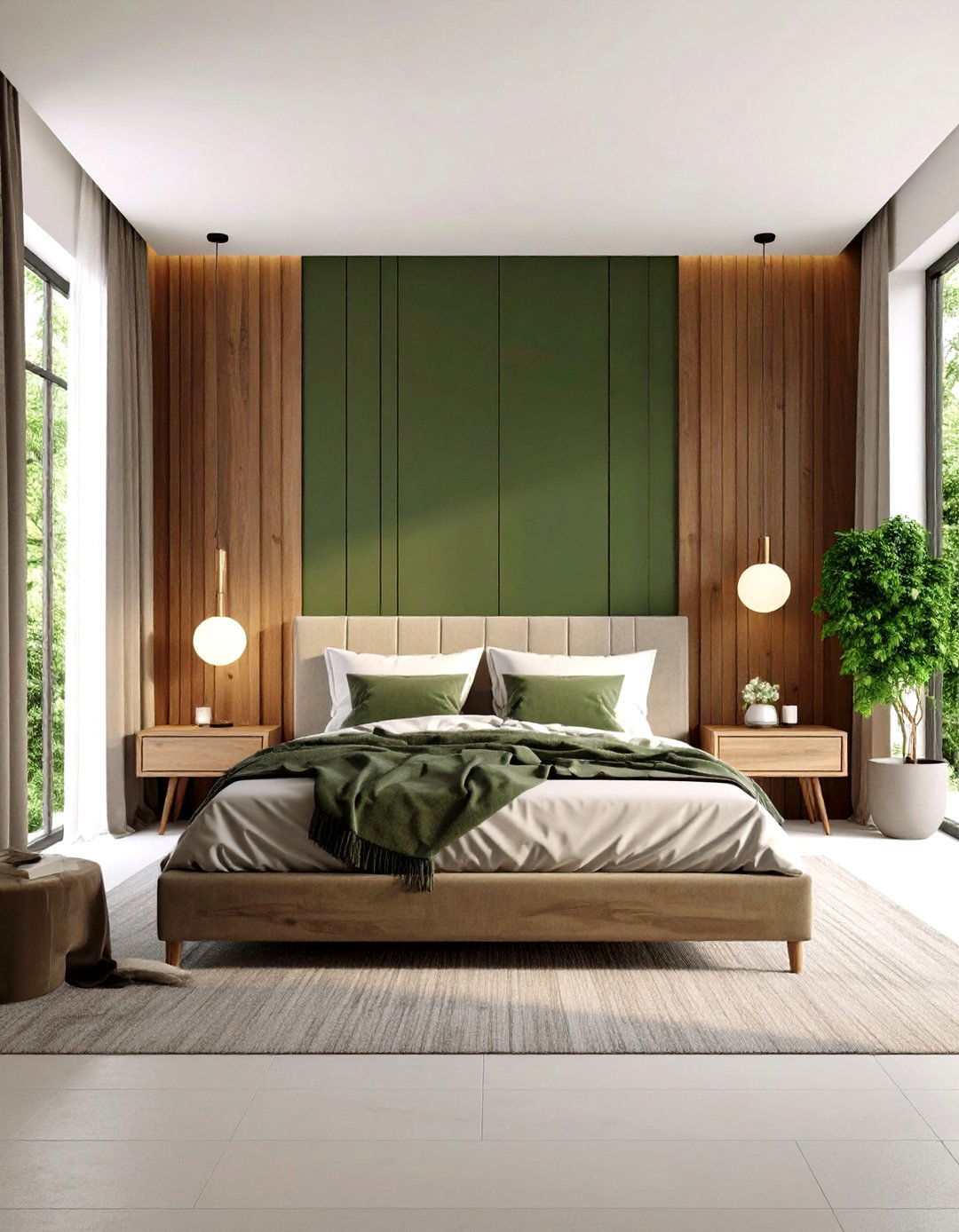

Leave a Reply